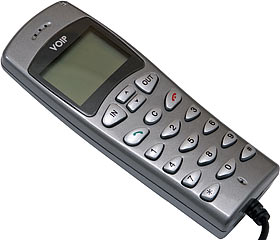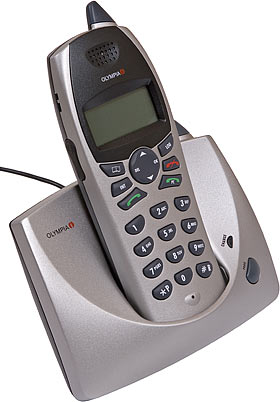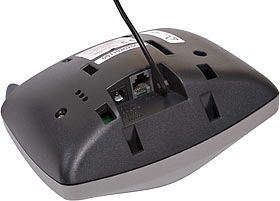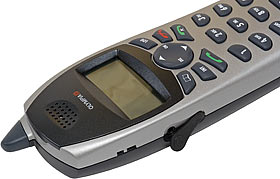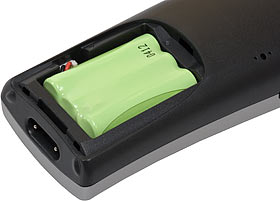
Voice Over IP for $60, or $200, or $0
Review date: 6 August 2005. Last modified 03-Dec-2011.
I first heard about Voice over IP (VoIP) more than ten years ago.
The idea's simple enough. If you've got a network connection to someone else (a local network, a private Wide Area Network, an Internet connection, or, heck, a dial-up or weirder modem connection), then you can send digitised voice data as easily as anything else. Voice doesn't take up a lot of bandwidth, and it doesn't take a lot of computing power to encode and decode it; any fast 486 or basic Pentium with a sound card, back in 1994, could handle telephony just fine.
In theory.
The problem was that back then, consumer broadband didn't exist. Most people with modems weren't even using them to access the Internet - it was the tail end of the age of the bulletin board. So not many people had a connection to a widespread network, and practically all of the connections that existed were via slow dial-up modems.
Dial-up has enough bandwidth to shift passable quality audio (though not a whole lot else at the same time), but its latency is lousy. Latency - known to gamers as "ping time" - is the length of time it takes data to move from one place to another, and the encode/decode process for dial-up modems is slow. Data going from one of the Unclean to the world can take 200 milliseconds (0.2 seconds) before it gets out of the ISP, a bit more time to get to the ISP of the destination, and then if the destination's on dial-up too, you're looking at another 200ms. Half a second of lag is perfectly possible. They wait that long to hear what you're saying, you wait that long to hear what they're saying back. A one second round-trip delay can really screw up a conversation.
People are used to dealing with a bit of lag for international calls. Most of it comes from the various switching, repeating and codec hardware in the signal path, not the actual transmission. Electrical signals travel at about around 200,000 kilometres per second (two-thirds of the speed of light), so a wire stretching all the way around the globe would only give you a signal delay of about a fifth of a second by itself (add exchanges and three seconds is more like it). Optical data transmission, which practically all phone calls these days use for some of their trip, is even faster. Long distance calls today are probably bouncing off a geosynchronous satellite, though; the up-and-back delay for light speed radio waves bouncing off one of those, assuming zero processing time in the satellite, is about 0.24 seconds.
(And yes, that's why satellite Internet access is no better than dialup for gaming.)
If you've got dial-up modems at either end of an Internet connection, you're never going to have a technology to compete with ordinary telephony. Early adopters back in '94 were using VoIP to make cheap lengthy calls to people far, far away, but they wouldn't have chosen it over a normal phone call if that cost the same. It was more of a walkie-talkie kind of experience. A $20 Radio Shack walkie-talkie kind of experience, at that.
Fast-forward to today, and suddenly everybody's using VoIP. Big businesses have retired their PABXes and piggybacked their phone calls onto their Internet connection, various companies are rolling out the lawyers, and, in a sure sign that the technology's taking off, the scam artists are moving in. But the real revolution is happening among home and small business users.
Now that low latency broadband connections are common (and, for VoIP purposes, any crummy entry level 128 kilobit ADSL connection is more than enough), regular people all over the world can connect for Internet voice telephony as easily as they can for e-mail or instant messaging or playing games. If you're discussing matters of national security then VoIP probably isn't for you, at least not yet - but transient Internet traffic has never been a real target for crackers; they're far more likely to get something of value by attacking servers than by sniffing packets.
All you need for VoIP communication is software, and the best software is free.
At the moment, Skype, from the maker of Kazaa, is by far the most popular VoIP product. The Dark Lord Murdoch wouldn't have almost bought it if it weren't. You just can't please some people, but for most of us, Skype's great.
Rupert was thinking of paying three billion US dollars for Skype, but its service will cost you, the Windows, Mac or Linux user, not a penny.
Well, probably not a penny.
If your Internet connection's charged by the megabyte, you'll pay for VoIP traffic, including Skype, just like anything else. If you've got any kind of half-decent download allowance, though, Skype is very unlikely to break your bandwidth budget.
(VoIP's an interesting technology for people with very little money, for this reason.)
The other way Skype can cost you money is if you want to call someone other than another Skype user. Skype lets you call normal phones too, but to do that you have to pay a per-minute fee to use "SkypeOut". Then, your Internet call terminates at a hub owned by Skype a cheap-call distance from the target phone, and the regular PSTN takes the call the rest of the way.
Many of the SkypeOut rates compare very well with normal long distance fees. Sometimes they're less of a bargain.
But let's get back to the totally-free side of things.
All you need to use VoIP in general, or Skype in particular, is audio output and input devices. Practically everyone with a computer these days has mic in and headphone out; all you need in addition is something to plug into those sockets.
Since you'll be using input and output simultaneously for a normal phone call, you'll want to avoid feedback from the output to the input. If you just sit a $5 microphone on your desk and use your vanilla suspiciously-cheap-computer-speakers-with-an-even-more-suspiciously-enormous-power-rating for output, you'll have created an extremely lo-fi delay pedal.
So, at minimum, you need a pair of headphones and a microphone. This isn't exactly a barrier to entry, though. Pretty much no microphone or pair of headphones is too bad for telephony.
So go on, then. If you haven't tried it already, even if you're some kind of Communist (Linux client here), you should download it, whip out the awful microphone and old foam-padded Walkman speakers of your choice, and get chatting to some computer-owning friend(s) of yours for free.
There's not much to learn about getting a good Skype connection. All you need is a bit of free upload and download bandwidth. That generally just means you have to stop perfectly legally downloading must-see TV for the duration of the call, though you can get fancier about it if you like. If you want to run bandwidth-hungry but lag-insensitive P2P applications along with bandwidth-light but lag-sensitive apps like Internet games and VoIP, a fancy traffic-sorting router becomes a useful project for the well-dressed nerd.
If Skype really works for you, you might want to make it more of a telephone-y experience.
This is surprisingly easy to do. Some geeks have been hacking up their own phone adapters, but all normal humans have to do is buy a VoIP phone peripheral (which won't necessarily look like a phone). The VoIP phone connects to a computer via USB and looks, to the computer, like a USB audio adapter with knobs on.
Those knobs, for most of these phones, are defined by SIP, the Session Initiation Protocol. SIP's basic purpose is to let the phone do phone-like things, like have its own dialling keypad, display information on its own screen, and ring when a call comes in. Various VoIP implementations support SIP, so most "Skype phones" shouldn't be a paperweight if you switch to some other VoIP app.
One big advantage of dedicated USB phone widgets is that, because they're separate audio devices, you don't have to juggle your sound between regular system audio and telephony. You won't get deafening phone rings interrupting your MP3s, you won't get system beeps echoing down the phone line (well, only insofar as the phone mic picks up what your normal speakers are doing, anyway).
The only downside to this is that it's possible to get your audio setup screwed up, as can also happen with USB modems, and discover that the phone has somehow become your default sound output device. These problems aren't hard to fix, though, and modern Windows flavours shouldn't develop them without malicious assistance. And, on the other hand, because the phone's a regular audio device, you can also use it with any other software you like - a phone's microphone isn't going to be studio quality, but if you just want to record some voice clips or use some random piece of other teleconferencing software that doesn't support SIP, it'll still be usable with the phone.
Here in Australia, Aus PC Market have a whole category devoted to VoIP phones. I checked a couple out.
No frills phoning
Here's a basic SIP VoIP phone, compatible with every recent VoIP app. It looks and feels like a middle-aged, middle-sized Nokia mobile phone, except for its USB-cable tether. It's made (or at least rebadged) by Sedna, and it's $AU60.50 delivered here in Australia, from Aus PC Market.
(Aussie shoppers who'd like to buy one can click here to order).
Like all proper VoIP phones, it's got noise reduction and echo cancellation, so its input and output don't interfere with each other. It's got an on-screen caller ID display (not totally useful for a phone that's tethered to a PC, but it doesn't do any harm), it remembers the last 199 received and called numbers for easy redialling,
It's even got multiple ringtones. Nothing too annoying, though.
UPDATE: Now there's a version of the Sedna phone that adds 128Mb of flash RAM, and works as a USB Mass Storage device as well as doing actual phone-y stuff. Why? So that you can put the VoIP installer of your choice on it, along with any other stuff you like. Plug the phone into any somewhat recent PC you like (recent Macs should be OK, too; no harm in carrying around both Windows and Mac installers), install the software from the new "drive", away you go.
The "128Mb" of memory will probably actually be more like 122Mb (128 million bytes), but the Skype installer's only about 7Mb in size and various other VoIP solutions are similarly small, so even with half a dozen installers on there, you'll still have space for some MP3s to listen to while you're waiting for the install-completion bar.
The price? $AU99, delivered. Aussie shoppers who'd like to buy this version can click here to order.
On to a fancier option.
Bells and whistles
This isn't a SIP phone; for VoIP, it works with Skype and Skype alone, and only on Windows 2000 and XP. That's because it uses its own software to connect the phone to Skype, and that software's only available for Windows.
The Australian distributor for this phone is Integrated Wireless, but the one I got for review has Olympia branding, under which the same product's available in Europe. In Tom's review of the Olympia version, they say the phone'll be sold with plain "DUALphone" branding in the states, which is how it's shown on the Integrated Wireless site. And, just to round things off, the Sedna site currently features it as a "coming soon" product.
Never mind the branding; look at the phone. It's quite recognisable, and its feature set is the same no matter what it's called where you live.
The "DUALphone" earns its name, because it also works as a regular landline phone...
...thanks to the ordinary modular socket on the base station.
Which, yes, means it's cordless. The base station will work when plugged into a phone line, or into a PC, or both. The phone's got one dialling button for normal calls, and one for Skype.
If you want to make a SkypeOut call, you just enter the phone number and then press the PC-call button. Either button, or just lifting the phone from its base station, will answer a call of any type. It doesn't get much simpler.
Like all decent cordless phones today, this is a digital unit, which means excellent sound quality over as long a range as any household user is likely to ever need, and no chance that your neighbour's going to pick up your phone calls on his mantle radio.
Aus PC Market sell the DUALphone for $AU214.50 delivered; they've also got extra handsets with their own charging base, which cost $AU110 delivered. You can have up to four handsets in total; if you've got more than one then you can do intercom calls between them. The base stations have no microphone or speaker and so can only page a handset, though.
The DUALphone package comes with a few extras, beyond the plugpack and phone cable and manual and software CD you'd expect (the software and manuals are also downloadable).
There's a clip-on bracket to stop the base station from falling over (which you leave off if you want to hang the base on the wall), and a belt clip for the phone. There are also two replaceable faceplates for the top portion of the phone, each of which is a more boring colour than the last.
(Oh, and you needn't worry about damaging the base station or phone antenna. It isn't one.)
There's also a little rubber-covered socket on the side for a headset, but you don't get a headset with the phone.
The DUALphone runs from a little NiMH battery pack, which is a standard item used by other cordless phones. It's probably this one, but maybe this one. I'd prefer it if the phone cost a tad more and used separate NiMH AAA cells, which you can buy cheaply anywhere, but it's no big thing.
The phone's battery life is OK, but not amazing. You get six and a half hours of talk time, and about four days of standby, after which the phone will start beeping at you for a recharge.
For your couple of hundred Australian dollars, the DUALphone gives you more than just cordlessness and landline compatibility. It's got its own 160-entry phone book (but a mere 30 entries in the redial and call logs), a display backlight, a keypad lock function and, yes, multiple ringtones (more useful here, since you can assign different ringtones to different kinds of incoming call), and it's got call waiting and call hold and all that stuff, so you can show off by putting a landline call on hold to make or answer a Skype call.
More importantly, you can change your VoIP online status from the handset, and view the status of people in your VoIP contacts list, and even have the phone beep at you when someone comes online. So just because you're digging up weeds in the garden, you don't have to miss the moment when your friend nine thousand miles away sits down at his computer.
The DUALphone doesn't assume it's the only phone in the house, either; it can tell you when someone else is making a landline call, or when someone else is using VoIP.
The interface frills, fortunately, don't get in the way of the phone's basic functions, which are all that most users are ever going to care about. The dual-standard compatibility really is very helpful; with zero fuss you can make a Skype or SkypeOut call to someone, and if it doesn't work properly you can hang up and call back on the landline right away.
Within Australia, the long distance SkypeOut evaluation calls that my executive testing vice-president selflessly made never worked flawlessly - calls to one recipient had lengthy international-style delay for no obvious reason, and even calls that seemed to be working fine tended to drop out about once an hour. Still, redialling wasn't a huge chore, and SkypeOut's 1.7 Euro cent per minute rate for calls to Australia (from anywhere) is a good deal compared with normal peak-time Australian long distance rates, let alone long distance rates from other countries.
The DUALphone has upgradeable firmware, too; the upgrades seem to be bundled in with the downloadable software updates.
Further options
If you don't need regular-phone integration, and you're happy to sit at your computer when you're making Skype calls, then a headset is the way to go. Aus PC have a range of those too. None of them are incredibly cheap, but if you're going to have the thing stuck on your head for hours on end, there's a reason to pay an extra $20.
The big headset users are, of course, gamers. Voice communication's normal for hard core Internet PC and console gamers these days, and there are various specialised VoIP options tuned to their special needs.
Oh, and someone's probably going to ask why I haven't mentioned Vonage yet. It's not because of E911 or affirmative acknowledgement or inadequate bribes; it's because Vonage's service isn't available outside the USA and Canada. WiMax doesn't reach this far.
Overall
If you're a gadget hound, there's a lot to love about VoIP. WiFi phones, tiny gadgets, money saving schemes and variably complex this-to-that hacking.
But if all that doesn't turn you on, today's VoIP is still a no-risk situation. There's no real barrier to entry at all. If you've got a computer; you can try very thoroughly before you buy, and you don't have to buy anything much at all.
If you want something better than a desk mic and $2 headphones, though, it's out there. A simple cabled phone like the Sedna gadget (with an honourable mention for the Flash-RAM version), or the full DUALphone option, which is eminently suitable for small business use, let alone home users. And not very expensive, for what it does; its only real limitation is that you can't use it with anything but Skype on Win2000/XP.
Buy one!
Readers from Australia or New Zealand can purchase VoIP phones from Aus
PC Market.
For the basic Sedna phone,
click here; for the one with 128Mb of Flash RAM,
click here.
For the DUALphone
click here; extra handsets are
here.
For the new video-capable version of Skype, Aus PC recommend
this camera!
(if you're NOT from Australia or New Zealand,
Aus PC Market won't deliver to you. If you're in the USA, try a price search
at
DealTime!)
